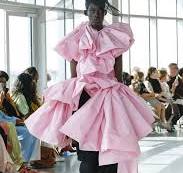The Evolution of Fashion
Fashion is a dynamic and ever-changing form of self-expression that has evolved significantly over the years. From ancient civilizations to modern-day trends, fashion has played a crucial role in shaping cultures and societies.
In ancient times, clothing was primarily worn for protection and modesty. However, as societies developed, fashion became a symbol of status, wealth, and identity. The Renaissance period marked a significant shift in fashion, with elaborate garments and accessories becoming popular among the nobility.
During the Industrial Revolution, mass production made fashionable clothing more accessible to the general population. This led to the rise of fashion houses and designers who created iconic styles that continue to influence trends today.
The 20th century saw rapid changes in fashion, with each decade bringing its own distinctive trends. From the flapper dresses of the 1920s to the punk rock style of the 1970s, fashion reflected the social and cultural movements of the time.
Today, fashion is more diverse and inclusive than ever before. With the rise of social media and online shopping, individuals have greater access to a wide range of styles and influences from around the world. Sustainable fashion practices are also gaining momentum as consumers become more conscious of their environmental impact.
Whether you prefer classic elegance or bold experimentation, fashion allows you to express your personality and creativity through clothing. As trends come and go, one thing remains constant – fashion will always be a powerful form of self-expression that continues to evolve with each passing era.
7 Benefits of Fashion: From Personal Expression to Career Opportunities
- Fashion allows individuals to express their unique personality and creativity through clothing choices.
- Following fashion trends can help individuals stay updated with current styles and influences.
- Fashion enables people to make a statement and showcase their individuality to the world.
- Wearing fashionable clothing can boost confidence and self-esteem, leading to a positive self-image.
- Fashion offers a creative outlet for designers and artists to showcase their talent and innovation.
- Exploring different fashion styles can be a fun and exciting way to experiment with new looks and aesthetics.
- Fashion industry provides numerous job opportunities ranging from design, marketing, retail, to modeling.
Seven Drawbacks of Modern Fashion: Environmental Impact, Financial Strain, and Ethical Concerns
- 1. Fast fashion contributes to environmental pollution and waste.
- 2. Pressure to constantly follow trends can lead to financial strain.
- 3. Exploitation of garment workers in the fashion industry is a prevalent issue.
- 4. Unrealistic beauty standards promoted by the fashion industry can negatively impact self-esteem.
- 5. Mass production of clothing often results in poor quality and short lifespan of garments.
- 6. Cultural appropriation is a common problem when designers appropriate traditional designs without proper credit or respect.
- 7. The emphasis on consumerism in fashion can promote excessive consumption and contribute to overconsumption.
Fashion allows individuals to express their unique personality and creativity through clothing choices.
Fashion offers individuals a captivating platform to showcase their distinct personality and unleash their creativity through the art of clothing selection. Whether opting for timeless classics or daring trends, one’s fashion choices serve as a visual representation of their inner self, allowing them to communicate without words. The ability to curate outfits that resonate with personal style preferences empowers individuals to craft their own narrative and stand out in a crowd, making fashion an invaluable tool for self-expression and individuality.
Following fashion trends can help individuals stay updated with current styles and influences.
Keeping up with fashion trends can be a valuable way for individuals to remain informed about the latest styles and influences in the fashion world. By following current trends, individuals can stay updated on what is popular and in vogue, allowing them to express their personal style in a contemporary and relevant manner. Whether it’s incorporating elements of the latest runway looks or adding a trendy accessory to their outfit, staying abreast of fashion trends can help individuals feel confident and stylish in their appearance.
Fashion enables people to make a statement and showcase their individuality to the world.
Fashion empowers individuals to communicate their unique personalities and perspectives to the world. Through clothing choices, accessories, and styling preferences, people can make a bold statement about who they are and what they stand for. Fashion serves as a powerful tool for self-expression, allowing individuals to showcase their creativity, confidence, and individuality in a visually striking way. Whether it’s through vibrant colours, unconventional silhouettes, or mix-and-match ensembles, fashion enables people to express themselves authentically and leave a lasting impression on those around them.
Wearing fashionable clothing can boost confidence and self-esteem, leading to a positive self-image.
When individuals choose to wear fashionable clothing, they often experience a boost in confidence and self-esteem. By selecting stylish and on-trend outfits that make them feel good, people can enhance their self-image and project a positive image to the world. The act of dressing in fashionable attire can empower individuals to feel more self-assured and comfortable in their own skin, ultimately contributing to a greater sense of confidence and well-being in various aspects of their lives.
Fashion offers a creative outlet for designers and artists to showcase their talent and innovation.
Fashion serves as a creative playground for designers and artists to exhibit their talent and ingenuity. It provides them with a platform to express their unique visions, experiment with new concepts, and push the boundaries of traditional aesthetics. Through innovative designs, intricate details, and bold statements, fashion designers can captivate audiences and leave a lasting impact on the industry. This pro of fashion not only nurtures creativity but also inspires future generations to explore their artistic abilities and contribute to the ever-evolving world of style and design.
Exploring different fashion styles can be a fun and exciting way to experiment with new looks and aesthetics.
Exploring different fashion styles can be a delightful and thrilling experience, offering a creative outlet to experiment with diverse looks and aesthetics. From classic elegance to bold and edgy trends, trying out various fashion styles allows individuals to express themselves uniquely and discover new aspects of their personal style. Embracing experimentation in fashion not only adds fun and excitement to one’s wardrobe but also fosters a sense of adventure and self-discovery through the ever-evolving world of style.
Fashion industry provides numerous job opportunities ranging from design, marketing, retail, to modeling.
The fashion industry offers a wide array of job opportunities spanning various roles such as design, marketing, retail, and modelling. This diverse sector not only caters to creative individuals with a passion for design but also provides avenues for those interested in business, sales, and promotion. From creating innovative clothing collections to developing compelling marketing campaigns, managing retail operations, or showcasing the latest trends on the runway, the fashion industry presents a dynamic and multifaceted landscape that welcomes individuals with a range of skills and talents.
1. Fast fashion contributes to environmental pollution and waste.
Fast fashion, a prevalent con in the fashion industry, significantly contributes to environmental pollution and waste. The rapid production and disposal of cheaply made clothing items result in increased carbon emissions, water pollution from dyeing processes, and excessive textile waste in landfills. The relentless cycle of fast fashion not only depletes finite resources but also poses a significant threat to our planet’s delicate ecosystem. It is crucial for consumers and industry players alike to address these environmental challenges by promoting sustainable practices and embracing conscious consumption habits to mitigate the detrimental impact of fast fashion on the environment.
2. Pressure to constantly follow trends can lead to financial strain.
One significant drawback of the fashion industry is the pressure to constantly follow trends, which can often result in financial strain for individuals. The fast-paced nature of fashion, with new trends emerging frequently, can create a sense of urgency to update one’s wardrobe regularly to stay current. This constant need to keep up with the latest styles and purchase new clothing items can lead to overspending and financial instability for many consumers. As a result, individuals may find themselves caught in a cycle of excessive consumption driven by the fear of falling behind in the ever-evolving world of fashion.
3. Exploitation of garment workers in the fashion industry is a prevalent issue.
The exploitation of garment workers in the fashion industry is a pressing concern that highlights the darker side of the glamorous world of fashion. From unsafe working conditions to unfair wages and long hours, many workers in the garment industry face exploitation and abuse in their pursuit to meet the demands of fast fashion. This unethical practice not only undermines the basic rights of these workers but also raises questions about the sustainability and ethics of the entire fashion supply chain. Efforts towards promoting fair labour practices and transparency within the industry are crucial steps towards addressing this significant con of fashion fashion.
4. Unrealistic beauty standards promoted by the fashion industry can negatively impact self-esteem.
The fashion industry’s promotion of unrealistic beauty standards can have detrimental effects on individuals’ self-esteem. By showcasing predominantly one-dimensional ideals of beauty through models and advertising campaigns, the industry perpetuates harmful stereotypes and unattainable standards that many people feel pressured to conform to. This can lead to feelings of inadequacy, low self-worth, and body image issues among those who do not fit the narrow definition of beauty portrayed in fashion media. It is essential for the industry to embrace diversity and promote body positivity to foster a more inclusive and empowering environment for all individuals.
5. Mass production of clothing often results in poor quality and short lifespan of garments.
The mass production of clothing in the fashion industry frequently leads to a notable drawback – the compromise on quality and durability of garments. With the emphasis on producing large quantities at rapid speeds, manufacturers may cut corners in terms of materials and craftsmanship, resulting in clothing items that are prone to wear and tear, fading colours, and seams coming apart after only a few wears. This throwaway culture not only impacts the environment due to increased waste but also undermines the value of well-made, long-lasting clothing pieces that can withstand the test of time.
6. Cultural appropriation is a common problem when designers appropriate traditional designs without proper credit or respect.
Cultural appropriation is a prevalent issue within the fashion industry, where designers often appropriate traditional designs without giving due credit or respect to the cultures they are borrowing from. This practice not only disrespects the rich heritage and significance of these traditional designs but also perpetuates harmful stereotypes and erases the cultural identities of the communities they belong to. It is essential for designers to approach cultural influences with sensitivity, awareness, and a genuine appreciation for the origins of the designs they incorporate into their collections, ensuring that proper credit is given and that cultural traditions are honoured and respected.
7. The emphasis on consumerism in fashion can promote excessive consumption and contribute to overconsumption.
The emphasis on consumerism in fashion can inadvertently promote excessive consumption and contribute to overconsumption. With the constant influx of new trends and styles, consumers may feel pressured to constantly update their wardrobes, leading to a cycle of buying and discarding clothing at a rapid pace. This culture of disposability not only has negative implications for the environment but also perpetuates unsustainable shopping habits. It is important for individuals to be mindful of their purchasing decisions and opt for quality over quantity to combat the harmful effects of overconsumption in the fashion industry.

